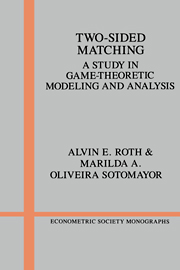Book contents
- Frontmatter
- Chapter 1 Introduction
- Part I One-to-one Matching: the Marriage Model
- Chapter 2 Stable matchings
- Chapter 3 The structure of the set of stable matchings
- Chapter 4 Strategic questions
- Part II Many-to-one matching: models in which firms may employ many workers
- Part III Models of one-to-one matching with money as a continuous variable
- Part IV Epilogue
- Bibliography
- Name Index
- Subject index
Chapter 3 - The structure of the set of stable matchings
from Part I - One-to-one Matching: the Marriage Model
Published online by Cambridge University Press: 05 January 2013
- Frontmatter
- Chapter 1 Introduction
- Part I One-to-one Matching: the Marriage Model
- Chapter 2 Stable matchings
- Chapter 3 The structure of the set of stable matchings
- Chapter 4 Strategic questions
- Part II Many-to-one matching: models in which firms may employ many workers
- Part III Models of one-to-one matching with money as a continuous variable
- Part IV Epilogue
- Bibliography
- Name Index
- Subject index
Summary
This chapter discusses the mathematical structure of the set of stable matchings, including some computational algorithms. Some readers may prefer to simply skim this chapter, at least on first reading.
The core of a game
One of the most important "solution concepts" in cooperative game theory is the core of a cooperative game. In this section we will see that the set of stable matchings in a marriage problem is equal to the core of the game. (In subsequent chapters we will see that in some of the more complex two-sided matching markets we will consider, the set of stable matchings may be only a subset of the core, and in the case of many-to-many matching, [pairwise] stable matchings need not even be in the core at all.)
As discussed earlier, when we formally model various kinds of games, we will generally want to specify a set of players, a set of feasible outcomes, preferences of players over outcomes, and rules, which determine how the game is played. In how much detail we will want and need to specify the rules will depend on what kind of phenomena we are describing, and what kind of theory we are trying to construct. It is often sufficient to summarize the rules of the game by specifying which coalitions (i.e., subsets) of players are empowered by the rules of the game to enforce which outcomes. (Thus in our analysis of the marriage market in Chapter 2, we concentrated on the fact that in order for a marriage to take place, it is necessary and sufficient for the man and woman involved to agree.)
- Type
- Chapter
- Information
- Two-Sided MatchingA Study in Game-Theoretic Modeling and Analysis, pp. 54 - 77Publisher: Cambridge University PressPrint publication year: 1990

